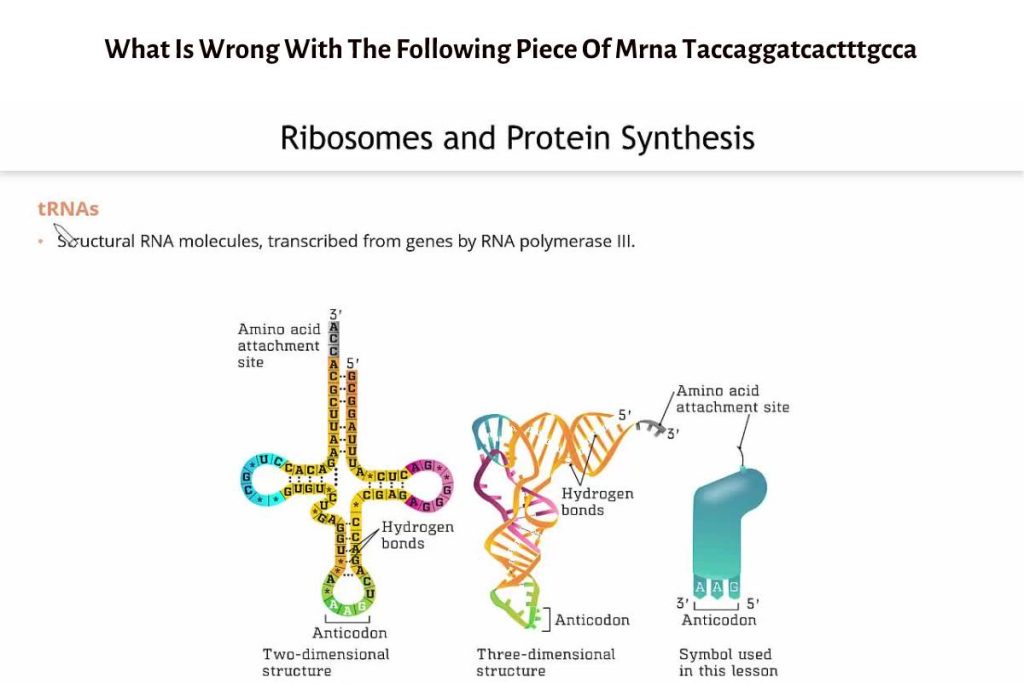Table of Contents
What Is Wrong With The Following Piece Of Mrna Taccaggatcactttgcca
What Is Wrong With The Following Piece Of Mrna Taccaggatcactttgcca mRNA, or messenger RNA, is a molecule that carries genetic information from DNA to ribosomes, where it is used to make proteins. mRNA comprises a chain of nucleotides consisting of a sugar, a phosphate group, and a nitrogenous base. There are four different types of nitrogenous bases in RNA: adenine (A), guanine (G), cytosine (C), and uracil (U).
The order of the bases in an mRNA molecule is called its codon sequence. Each codon consists of three bases and codes for a specific amino acid. The order of the codons in the mRNA molecule determines the order of the amino acids in a protein.
A few things could be wrong with the mRNA sequence Taccaggatcactttgcca.
There could be a mutation, a change in the base sequence. Mutations can occur spontaneously or be caused by environmental factors such as radiation or chemicals. Mutations can not affect the protein produced but can sometimes lead to changes in the protein’s structure or function.
Another possibility is that the mRNA molecule is missing some bases. It is called a deletion. Deletions can also occur spontaneously or be caused by environmental factors. Deletions can not affect the protein produced but can sometimes lead to the protein being truncated or shortened.
Finally, it is also possible that the mRNA molecule has extra bases. It is called an insertion. Insertions can also occur spontaneously or be caused by environmental factors. Insertions can sometimes not affect the protein produced, but they can also sometimes lead to the protein being frameshifted or having its amino acid sequence changed.
What Is The Transcription Of Mrna?
The term “transcription” itself refers to copying DNA into RNA. So, asking about the transcription of mRNA doesn’t quite make sense because mRNA is already an RNA molecule and wouldn’t be transcribed further.
Perhaps You Meant To Ask:
- The DNA sequence from which the mRNA was transcribed: In this case, you would need to provide the mRNA sequence for me to analyze and predict the corresponding DNA sequence based on complementary base pairing rules.
- The translation of the mRNA: This refers to the process of decoding the mRNA codons into amino acids to build a protein. If that’s your question, please provide the mRNA sequence, and I can translate it.
What Is Mrna Structure?
mRNA, or messenger RNA, plays a crucial role in carrying genetic information from DNA to ribosomes, where it guides protein synthesis. Its seemingly simple structure holds critical features that enable this vital function. Here’s a breakdown of an mRNA molecule:
Basic components: Wrong With The Following Piece Of Mrna Taccaggatcactttgcca
- Linear chain of nucleotides: Each nucleotide consists of a sugar molecule (ribose), a phosphate group, and a nitrogenous base. mRNA contains four base types: adenine (A), guanine (G), cytosine (C), and uracil (U).
- Single-stranded: Unlike DNA, which forms a double helix, mRNA exists as a single strand.
- Essential regions:
- 5′ cap: A modified guanine nucleotide at the mRNA’s start (5′ end). It protects the mRNA from degradation and aids in ribosome binding.
- 5′ untranslated region (UTR): A non-coding sequence upstream of the coding region. It influences translation efficiency and stability.
- Coding region: Contains codons and triplets of bases that specify amino acids. The order of codons determines the protein sequence.
- 3′ untranslated region (UTR): Another non-coding sequence downstream of the coding region. It plays a role in mRNA stability, localization, and translation regulation.
- Poly(A) tail: A sequence of multiple adenosine nucleotides added to the 3′ end. It enhances mRNA stability, export from the nucleus, and translation.
Additional features:
- Secondary structure: Although linear, mRNA can fold into complex shapes due to base pairing within the molecule, affecting its function and interaction with other molecules.
- Modifications: Specific nucleotides within the mRNA can be modified by enzymes, influencing its stability, translation efficiency, and other regulatory processes.
- Eukaryotic vs. prokaryotic mRNA:
While the basic structure is similar, differences exist between eukaryotic and prokaryotic mRNA. Eukaryotic mRNA undergoes splicing, removing non-coding introns from the precursor molecule, before becoming mature mRNA. Prokaryotic mRNA typically lacks a cap and poly(A) tail and may be translated even before complete transcription.
Understanding the structure of mRNA is crucial for appreciating its role in protein synthesis and its potential involvement in various diseases and biological processes.
Conclusion
mRNA, or messenger RNA, is a molecule that carries genetic information from DNA to ribosomes, where it is used to make proteins. mRNA comprises a chain of nucleotides consisting of a sugar, a phosphate group, and a nitrogenous base. The order of the bases in an mRNA molecule is called its codon sequence. The order of the codons in the mRNA molecule determines the order of the amino acids in a protein. Insertions can sometimes not affect the protein produced, but they can also sometimes lead to the protein being frame shifted or having its amino acid sequence changed.
The translation of the mRNA: This refers to the process of decoding the mRNA codons into amino acids to build a protein. mRNA, or messenger RNA, plays a crucial role in carrying genetic information from DNA to ribosomes, where it guides protein synthesis.
READ ALSO: Five Star Coin Yokai Watch 2
